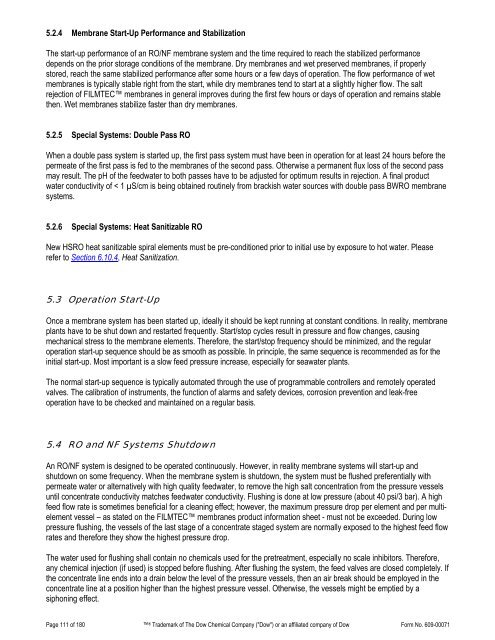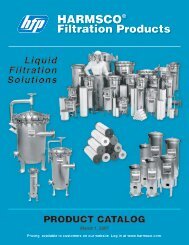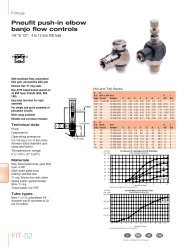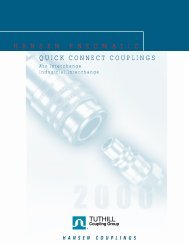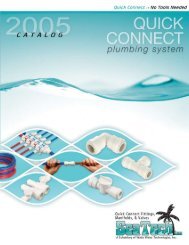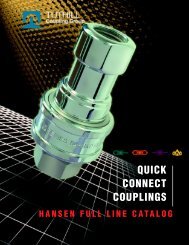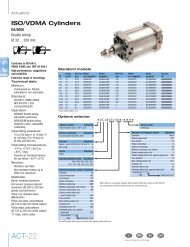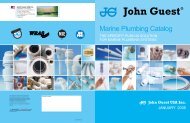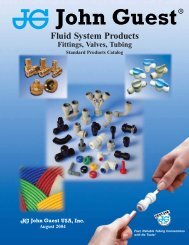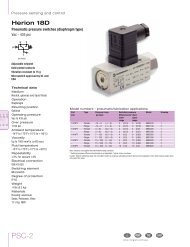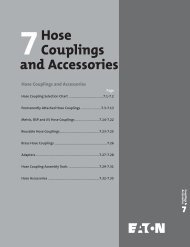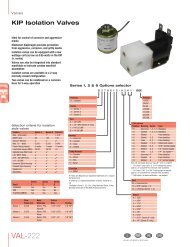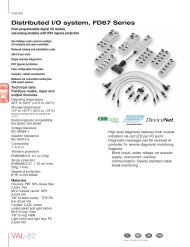FilmTec Technical Manual - Chester Paul Company
FilmTec Technical Manual - Chester Paul Company
FilmTec Technical Manual - Chester Paul Company
You also want an ePaper? Increase the reach of your titles
YUMPU automatically turns print PDFs into web optimized ePapers that Google loves.
5.2.4 Membrane Start-Up Performance and StabilizationThe start-up performance of an RO/NF membrane system and the time required to reach the stabilized performancedepends on the prior storage conditions of the membrane. Dry membranes and wet preserved membranes, if properlystored, reach the same stabilized performance after some hours or a few days of operation. The flow performance of wetmembranes is typically stable right from the start, while dry membranes tend to start at a slightly higher flow. The saltrejection of FILMTEC membranes in general improves during the first few hours or days of operation and remains stablethen. Wet membranes stabilize faster than dry membranes.5.2.5 Special Systems: Double Pass ROWhen a double pass system is started up, the first pass system must have been in operation for at least 24 hours before thepermeate of the first pass is fed to the membranes of the second pass. Otherwise a permanent flux loss of the second passmay result. The pH of the feedwater to both passes have to be adjusted for optimum results in rejection. A final productwater conductivity of < 1 µS/cm is being obtained routinely from brackish water sources with double pass BWRO membranesystems.5.2.6 Special Systems: Heat Sanitizable RONew HSRO heat sanitizable spiral elements must be pre-conditioned prior to initial use by exposure to hot water. Pleaserefer to Section 6.10.4, Heat Sanitization.5.3 Operation Start-UpOnce a membrane system has been started up, ideally it should be kept running at constant conditions. In reality, membraneplants have to be shut down and restarted frequently. Start/stop cycles result in pressure and flow changes, causingmechanical stress to the membrane elements. Therefore, the start/stop frequency should be minimized, and the regularoperation start-up sequence should be as smooth as possible. In principle, the same sequence is recommended as for theinitial start-up. Most important is a slow feed pressure increase, especially for seawater plants.The normal start-up sequence is typically automated through the use of programmable controllers and remotely operatedvalves. The calibration of instruments, the function of alarms and safety devices, corrosion prevention and leak-freeoperation have to be checked and maintained on a regular basis.5.4 RO and NF Systems ShutdownAn RO/NF system is designed to be operated continuously. However, in reality membrane systems will start-up andshutdown on some frequency. When the membrane system is shutdown, the system must be flushed preferentially withpermeate water or alternatively with high quality feedwater, to remove the high salt concentration from the pressure vesselsuntil concentrate conductivity matches feedwater conductivity. Flushing is done at low pressure (about 40 psi/3 bar). A highfeed flow rate is sometimes beneficial for a cleaning effect; however, the maximum pressure drop per element and per multielementvessel – as stated on the FILMTEC membranes product information sheet - must not be exceeded. During lowpressure flushing, the vessels of the last stage of a concentrate staged system are normally exposed to the highest feed flowrates and therefore they show the highest pressure drop.The water used for flushing shall contain no chemicals used for the pretreatment, especially no scale inhibitors. Therefore,any chemical injection (if used) is stopped before flushing. After flushing the system, the feed valves are closed completely. Ifthe concentrate line ends into a drain below the level of the pressure vessels, then an air break should be employed in theconcentrate line at a position higher than the highest pressure vessel. Otherwise, the vessels might be emptied by asiphoning effect.Page 111 of 180 ® Trademark of The Dow Chemical <strong>Company</strong> ("Dow") or an affiliated company of Dow Form No. 609-00071


